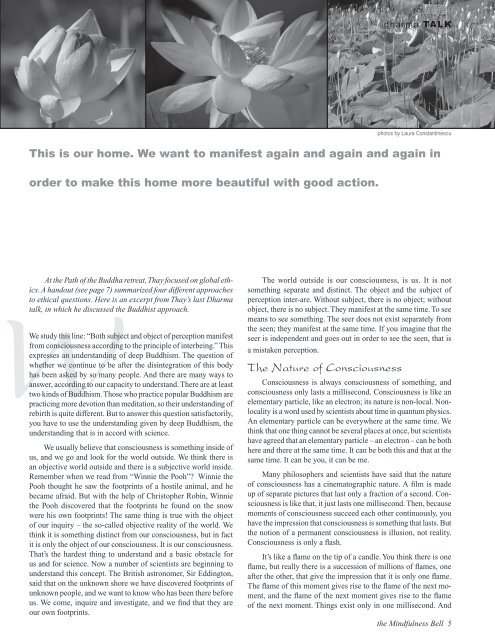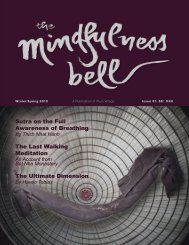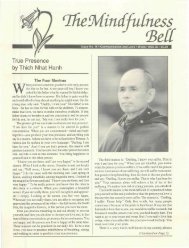View full issue in PDF - The Mindfulness Bell
View full issue in PDF - The Mindfulness Bell
View full issue in PDF - The Mindfulness Bell
- No tags were found...
You also want an ePaper? Increase the reach of your titles
YUMPU automatically turns print PDFs into web optimized ePapers that Google loves.
dharma TALKphotos by Laura Constant<strong>in</strong>escuThis is our home. We want to manifest aga<strong>in</strong> and aga<strong>in</strong> and aga<strong>in</strong> <strong>in</strong>order to make this home more beautiful with good action.At the Path of the Buddha retreat, Thay focused on global ethics.A handout (see page 7) summarized four different approachesto ethical questions. Here is an excerpt from Thay’s last Dharmatalk, <strong>in</strong> which he discussed the Buddhist approach.We study this l<strong>in</strong>e: “Both subject and object of perception manifestfrom consciousness accord<strong>in</strong>g to the pr<strong>in</strong>ciple of <strong>in</strong>terbe<strong>in</strong>g.” Thisexpresses an understand<strong>in</strong>g of deep Buddhism. <strong>The</strong> question ofwhether we cont<strong>in</strong>ue to be after the dis<strong>in</strong>tegration of this bodyhas been asked by so many people. And there are many ways toanswer, accord<strong>in</strong>g to our capacity to understand. <strong>The</strong>re are at leasttwo k<strong>in</strong>ds of Buddhism. Those who practice popular Buddhism arepractic<strong>in</strong>g more devotion than meditation, so their understand<strong>in</strong>g ofrebirth is quite different. But to answer this question satisfactorily,you have to use the understand<strong>in</strong>g given by deep Buddhism, theunderstand<strong>in</strong>g that is <strong>in</strong> accord with science.We usually believe that consciousness is someth<strong>in</strong>g <strong>in</strong>side ofus, and we go and look for the world outside. We th<strong>in</strong>k there isan objective world outside and there is a subjective world <strong>in</strong>side.Remember when we read from “W<strong>in</strong>nie the Pooh”? W<strong>in</strong>nie thePooh thought he saw the footpr<strong>in</strong>ts of a hostile animal, and hebecame afraid. But with the help of Christopher Rob<strong>in</strong>, W<strong>in</strong>niethe Pooh discovered that the footpr<strong>in</strong>ts he found on the snowwere his own footpr<strong>in</strong>ts! <strong>The</strong> same th<strong>in</strong>g is true with the objectof our <strong>in</strong>quiry – the so-called objective reality of the world. Weth<strong>in</strong>k it is someth<strong>in</strong>g dist<strong>in</strong>ct from our consciousness, but <strong>in</strong> factit is only the object of our consciousness. It is our consciousness.That’s the hardest th<strong>in</strong>g to understand and a basic obstacle forus and for science. Now a number of scientists are beg<strong>in</strong>n<strong>in</strong>g tounderstand this concept. <strong>The</strong> British astronomer, Sir Edd<strong>in</strong>gton,said that on the unknown shore we have discovered footpr<strong>in</strong>ts ofunknown people, and we want to know who has been there beforeus. We come, <strong>in</strong>quire and <strong>in</strong>vestigate, and we f<strong>in</strong>d that they areour own footpr<strong>in</strong>ts.<strong>The</strong> world outside is our consciousness, is us. It is notsometh<strong>in</strong>g separate and dist<strong>in</strong>ct. <strong>The</strong> object and the subject ofperception <strong>in</strong>ter-are. Without subject, there is no object; withoutobject, there is no subject. <strong>The</strong>y manifest at the same time. To seemeans to see someth<strong>in</strong>g. <strong>The</strong> seer does not exist separately fromthe seen; they manifest at the same time. If you imag<strong>in</strong>e that theseer is <strong>in</strong>dependent and goes out <strong>in</strong> order to see the seen, that isa mistaken perception.<strong>The</strong> Nature of ConsciousnessConsciousness is always consciousness of someth<strong>in</strong>g, andconsciousness only lasts a millisecond. Consciousness is like anelementary particle, like an electron; its nature is non-local. Nonlocalityis a word used by scientists about time <strong>in</strong> quantum physics.An elementary particle can be everywhere at the same time. Weth<strong>in</strong>k that one th<strong>in</strong>g cannot be several places at once, but scientistshave agreed that an elementary particle – an electron – can be bothhere and there at the same time. It can be both this and that at thesame time. It can be you, it can be me.Many philosophers and scientists have said that the natureof consciousness has a c<strong>in</strong>ematographic nature. A film is madeup of separate pictures that last only a fraction of a second. Consciousnessis like that, it just lasts one millisecond. <strong>The</strong>n, becausemoments of consciousness succeed each other cont<strong>in</strong>uously, youhave the impression that consciousness is someth<strong>in</strong>g that lasts. Butthe notion of a permanent consciousness is illusion, not reality.Consciousness is only a flash.It’s like a flame on the tip of a candle. You th<strong>in</strong>k there is oneflame, but really there is a succession of millions of flames, oneafter the other, that give the impression that it is only one flame.<strong>The</strong> flame of this moment gives rise to the flame of the next moment,and the flame of the next moment gives rise to the flameof the next moment. Th<strong>in</strong>gs exist only <strong>in</strong> one millisecond. Andthe M<strong>in</strong>dfulness <strong>Bell</strong> 5
















